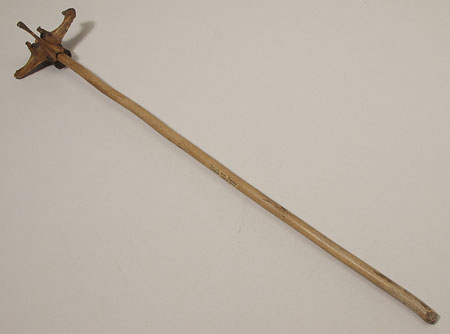Accession Number:
1934.8.16
Country:
Sudan
Region:
[Southern Sudan] ?Warab Kornuk
Cultural Group:
Dinka
Date Made:
By May 1933
Materials:
Animal Bone , ?Cattle Bone Animal , Wood Plant
Process:
Carved , Polished
Dimensions:
Stick L = 660, W = 13.9, th = 13.5 mm; vertebra head L = 140 mm, W = 84 mm, Ht = 59.5 mm [RTS 9/8/2004].
Weight:
124.8 g
Other Owners:
Collected by Percy Horace Gordon Powell-Cotton and his wife Hannah Powell-Cotton (nee Hannah Brayton Slater) on 25th May 1933 during a shooting expedition.
Field Collector:
Percy Horace Gordon Powell-Cotton & Hannah Powell-Cotton (nee Hannah Brayton Slater)
PRM Source:
Percy Horace Gordon Powell-Cotton
Acquired:
Donated 1934
Collected Date:
25th May 1933
Description:
Food stirrer made from a short wooden stick, round in section, shaved to form a rounded end at the top and an angular point with faceted sides at the base.
The body is straight but has a few natural irregularities that reflect the shape of the original branch; this is a light yellowish brown colour (Pantone 7509C) and the surface has been polished.
A large animal vertebra has been fitted onto the top of the stick to form a stirring head; the size suggests that this could be from a cow or bull.
This has a spool-shaped back with concave sides and three flat blades projecting outwards.
It does not appear to have been modified, although the surface may have become stained through use; the underlying bone is an orangey yellow colour (Pantone 722C).
The stirrer is complete and intact, and has a weight of 124.8 grams.
The stick is 660 mm long, 13.9 mm wide and 13.5 mm thick.
The bone head is 140 mm long and 84 mm wide, with a height of 59.5 mm.
Collected by Percy Horace Gordon Powell-Cotton and his wife Hannah Powell-Cotton (nee Hannah Brayton Slater) at Kornuk on 25th May 1933 during a shooting expedition. The Powell-Cotton's also shot film footage during their visit to the region (see the description in Mrs Powell Cotton, "Village Handicrafts in the Sudan", Man 34 (112), pp 90-91).
Powell-Cotton does not give the local name for this type of object, but they were used as food stirrers, as well as being carried by women at dances.
Rachael Sparks & Jeremy Coote 20/08/2005.
Collected by Percy Horace Gordon Powell-Cotton and his wife Hannah Powell-Cotton (nee Hannah Brayton Slater) at Kornuk on 25th May 1933 during a shooting expedition. The Powell-Cotton's also shot film footage during their visit to the region (see the description in Mrs Powell Cotton, "Village Handicrafts in the Sudan", Man 34 (112), pp 90-91).
Powell-Cotton does not give the local name for this type of object, but they were used as food stirrers, as well as being carried by women at dances.
Rachael Sparks & Jeremy Coote 20/08/2005.
Primary Documentation:
Accession Book Entry
[p.
248] 1934 [insert] 8 [end insert] -
MAJOR P.
H.
G.
POWELL-COTTON
, Quex Park, Birchington, E.
Kent.
Specimens collected by himself & Mrs Cotton, during hunting trips, 1933, viz: - From the
DINKA
tribe, FANAMWEIR & KORNUK, WHITE NILE [...] [insert] 16 [end insert] - Swizzle-stick with large vertebra for head, ib[idem] [KORNUK].
Additional Accession Book Entry [p. 247] - 1934.8.16 No given AP l[ength] = 670 mm [in red biro] A20 F10 9.
Card Catalogue Entry - There is no further information on the catalogue card [RTS 6/4/2004].
Related Documents File - Typewritten List of "Curios Presented to Dr. Balfour by Major & Mrs. Powell-Cotton. Dinka Tribe". This object appears as item 2543: "Swizzle stick, Vert. bone head, 25/5/33 Kornuk, 7.53 N 28.9 E". Also contains details of a cine film 'some tribes of the Southern Sudan', taken by Powell-Cotton during this 1933 expedition, copies of which are now in the National Film and Television Archive and the Powell-Cotton Museum in Kent [RTS 14/3/2005].
Written on object - Swizzle-stick, DINKA, KORNUK, WHITE NILE, 7° 53' N., 28° 9' E. d.d. Major Powell-Cotton, 1934.8.16 (2543) [ink, on wooden body] 2543 [pencil, on bone vertebra, RTS 9/8/2004].
Additional Accession Book Entry [p. 247] - 1934.8.16 No given AP l[ength] = 670 mm [in red biro] A20 F10 9.
Card Catalogue Entry - There is no further information on the catalogue card [RTS 6/4/2004].
Related Documents File - Typewritten List of "Curios Presented to Dr. Balfour by Major & Mrs. Powell-Cotton. Dinka Tribe". This object appears as item 2543: "Swizzle stick, Vert. bone head, 25/5/33 Kornuk, 7.53 N 28.9 E". Also contains details of a cine film 'some tribes of the Southern Sudan', taken by Powell-Cotton during this 1933 expedition, copies of which are now in the National Film and Television Archive and the Powell-Cotton Museum in Kent [RTS 14/3/2005].
Written on object - Swizzle-stick, DINKA, KORNUK, WHITE NILE, 7° 53' N., 28° 9' E. d.d. Major Powell-Cotton, 1934.8.16 (2543) [ink, on wooden body] 2543 [pencil, on bone vertebra, RTS 9/8/2004].





